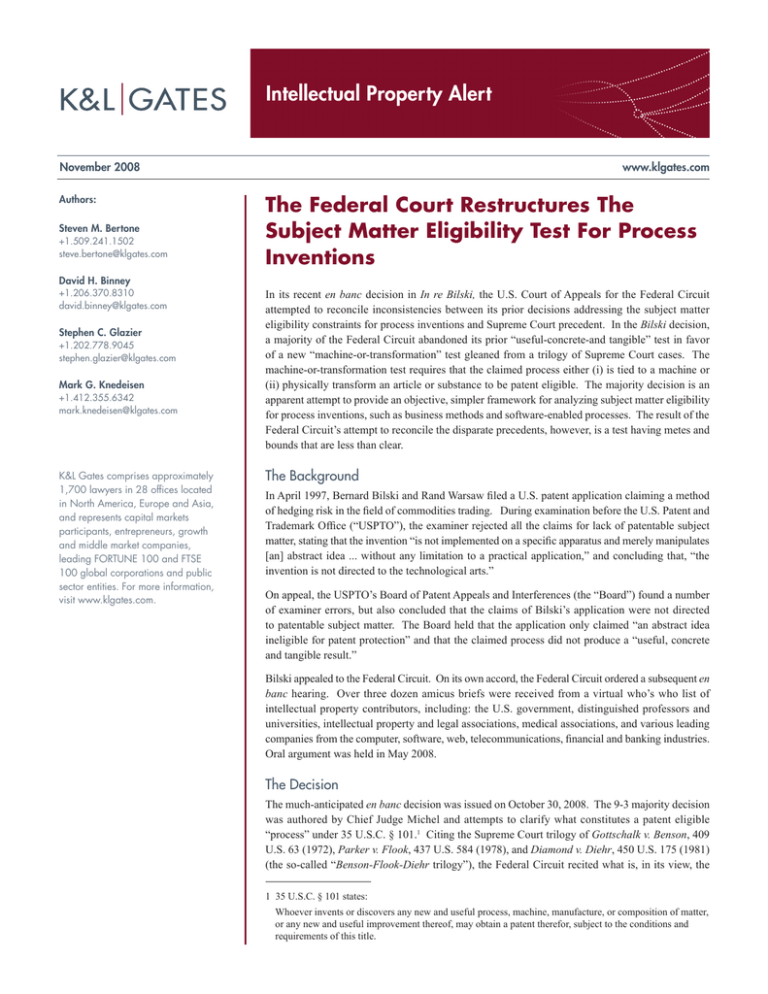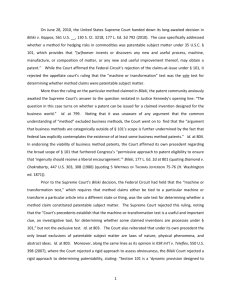
Intellectual Property Alert
November 2008
Authors:
Steven M. Bertone
+1.509.241.1502
steve.bertone@klgates.com
www.klgates.com
The Federal Court Restructures The
Subject Matter Eligibility Test For Process
Inventions
David H. Binney
+1.206.370.8310
david.binney@klgates.com
Stephen C. Glazier
+1.202.778.9045
stephen.glazier@klgates.com
Mark G. Knedeisen
+1.412.355.6342
mark.knedeisen@klgates.com
K&L Gates comprises approximately
1,700 lawyers in 28 offices located
in North America, Europe and Asia,
and represents capital markets
participants, entrepreneurs, growth
and middle market companies,
leading FORTUNE 100 and FTSE
100 global corporations and public
sector entities. For more information,
visit www.klgates.com.
In its recent en banc decision in In re Bilski, the U.S. Court of Appeals for the Federal Circuit
attempted to reconcile inconsistencies between its prior decisions addressing the subject matter
eligibility constraints for process inventions and Supreme Court precedent. In the Bilski decision,
a majority of the Federal Circuit abandoned its prior “useful-concrete-and tangible” test in favor
of a new “machine-or-transformation” test gleaned from a trilogy of Supreme Court cases. The
machine-or-transformation test requires that the claimed process either (i) is tied to a machine or
(ii) physically transform an article or substance to be patent eligible. The majority decision is an
apparent attempt to provide an objective, simpler framework for analyzing subject matter eligibility
for process inventions, such as business methods and software-enabled processes. The result of the
Federal Circuit’s attempt to reconcile the disparate precedents, however, is a test having metes and
bounds that are less than clear.
The Background
In April 1997, Bernard Bilski and Rand Warsaw filed a U.S. patent application claiming a method
of hedging risk in the field of commodities trading. During examination before the U.S. Patent and
Trademark Office (“USPTO”), the examiner rejected all the claims for lack of patentable subject
matter, stating that the invention “is not implemented on a specific apparatus and merely manipulates
[an] abstract idea ... without any limitation to a practical application,” and concluding that, “the
invention is not directed to the technological arts.”
On appeal, the USPTO’s Board of Patent Appeals and Interferences (the “Board”) found a number
of examiner errors, but also concluded that the claims of Bilski’s application were not directed
to patentable subject matter. The Board held that the application only claimed “an abstract idea
ineligible for patent protection” and that the claimed process did not produce a “useful, concrete
and tangible result.”
Bilski appealed to the Federal Circuit. On its own accord, the Federal Circuit ordered a subsequent en
banc hearing. Over three dozen amicus briefs were received from a virtual who’s who list of
intellectual property contributors, including: the U.S. government, distinguished professors and
universities, intellectual property and legal associations, medical associations, and various leading
companies from the computer, software, web, telecommunications, financial and banking industries.
Oral argument was held in May 2008.
The Decision
The much-anticipated en banc decision was issued on October 30, 2008. The 9-3 majority decision
was authored by Chief Judge Michel and attempts to clarify what constitutes a patent eligible
“process” under 35 U.S.C. § 101.1 Citing the Supreme Court trilogy of Gottschalk v. Benson, 409
U.S. 63 (1972), Parker v. Flook, 437 U.S. 584 (1978), and Diamond v. Diehr, 450 U.S. 175 (1981)
(the so-called “Benson-Flook-Diehr trilogy”), the Federal Circuit recited what is, in its view, the
1 35 U.S.C. § 101 states:
Whoever invents or discovers any new and useful process, machine, manufacture, or composition of matter,
or any new and useful improvement thereof, may obtain a patent therefor, subject to the conditions and
requirements of this title.
Intellectual Property Alert
Supreme Court’s “definitive test” for determining whether
a “process” is patentable subject matter under § 101 of
the patent statute. The “definitive test,” according to the
Bilski majority, is that a process is “surely patent-eligible
if: (1) it is tied to a particular machine or apparatus, or
(2) it transforms a particular article into a different state
or thing.”2 The Federal Circuit referred to this test as the
“machine-or-transformation” test.3 The purpose of the test
is to prevent preemption of a fundamental principle. The
majority reasoned that if a claimed process is either tied to
a machine or causes a physical transformation, the process
would not preempt substantially all uses of the fundamental
principle embodied in the process.
The Federal Circuit provided some, but not complete, clarity
for the metes and bounds for the machine-or-transformation
test. The Federal Circuit stated that “a specific machine or
transformation of an article must impose meaningful limits
on the claim’s scope to impart patent-eligibility,” and that
“the involvement of the machine or transformation in the
claimed process must not merely be insignificant extrasolution activity.”
Because Bilski admitted that his claimed process did not
include a machine, the Federal Circuit did not elaborate
more on the types of machines that would satisfy the
“machine” prong of the test. The court did, however, address
the “transformation” prong of the test in some detail. The
majority states that a process involving a transformation
only qualifies as patent eligible if it transforms the character
of an article or substance. The Federal Circuit, drawing
on In re Abele, 684 F.2d 902 (C.C.P.A. 1982), opined that
a process that transforms data representing physical and
tangible objects or substances is patent eligible. On the other
hand, the court stated that a process transforming data that
does not represent anything tangible, such as public or private
legal obligations or relationships, business risks, or other
such abstractions, is not patent eligible under § 101.
2 S ee Benson, 409 U.S. at 70 (“Transformation and reduction
of an article ‘to a different state or thing’ is the clue to the
patentability of a process claim that does not include particular
machines”); Diehr, 450 U.S. at 192 (holding that use of a
mathematical formula in a process “transforming or reducing
an article to a different state of thing” constitutes patenteligible subject matter); Flook, 437 U.S. at 589, n.9 (“An
argument can be made [that the Supreme] Court has only
recognized a process as within the statutory definition when it
either was tied to a particular apparatus or operated to change
materials to a ‘different state or thing’”).
3 P
atent eligibility under § 101 is only a first hurdle to issuing
a patent. If a patent application claims patent eligible subject
matter under § 101, then the patent must still be novel under
§ 102, and non-obvious under § 103. The Federal Circuit did
not address whether Bilski’s invention satisfied § 102
and § 103.
The majority in Bilski rejected the “useful, concrete, and
tangible result” test, previously adopted by the Federal
Circuit for patent eligibility for processes under § 101. That
test required that to be patent eligible, a claimed process
must “produce a useful concrete and tangible result.” See
State Street Bank & Trust Company v. Signature Financial
Group, 149 F.3d 1368 (Fed. Cir. 1998); AT&T Corp. v. Excel
Communications, Inc., 172 F.3d 1352 (Fed. Cir. 1998).
Judges Dyk and Linn filed a concurring opinion that argued
that the court’s decision was grounded in the meaning of §
101 and that the court had not assumed a legislative role.
Judges Newman, Mayer, and Rader dissented. Judge
Newman argued that the majority opinion’s “machine-ortransformation” test conflicts with Supreme Court precedent.
Judge Mayer dissented because the majority did not expressly
overrule State Street. Judge Rader’s dissent argued that
existing Supreme Court precedent established that Bilski’s
claimed method was an attempt to patent nothing more
than an abstract idea and, therefore, was not patentable
under § 101.
Given the significant commercial implications of the Bilski
decision and the number of patents and pending patent
applications directed to software processes, business methods,
and other non-industrial processes, some commentators
speculate that the Supreme Court will review the decision
on certiorari. The majority opinion in Bilski relies heavily
on Supreme Court decisions as bases for its holding, which
may render the possibility of Supreme Court review less
likely. However, until the Supreme Court reviews Bilski
or lower courts provide further clarity through subsequent
decisions, the complete bounds of the test will remain
somewhat unclear.
Analysis
Bilski affects patents and patent applications claiming
processes including software-implemented processes and
business methods in several interesting ways. Because
Bilski is an en banc decision, it has greater precedential
weight than the panel decisions in State Street and AT&T.
Furthermore, the Bilski majority was explicit in stating it
was overruling State Street only to the extent of changing the
useful-tangible-concrete result test, but the opinion does not
state whether the claimed inventions at issue in State Street
and AT&T would qualify as patentable subject matter under
the machine-or-transformation test.
In view of Bilski, it will be important to draft claims and
an enabling technical disclosure that satisfy the machineor-transformation test. A specific description of how an
invention operates on a particular machine and/or involves
November 2008
Intellectual Property Alert
a physical transformation will be of paramount value. As
such, the machine-or-transformation test may be problematic
to pending business method patent applications in which the
claims cannot be amended to include reference to a specific
machine. For other types of processes, the court left open the
possibility that it would find non-eligible subject matter if the
link to the machine appears merely tangential to the claimed
process. Presumably, claim drafters can recite the use of a
machine in virtually any method enabled by software. The
key—both in prosecution and enforcement—will be whether
the recited machine is “meaningful” to the claimed process
and not “insignificant extra-solution activity.” We suggest
that claim drafters adhere to the guidance provided in the
Benson-Flook-Diehr trilogy.
For existing patents and patent applications, Bilski suggests
the need to audit patent portfolios and consider modifying
pending or issued claims when possible to comply with
the machine-or-transformation test. It is unclear how the
USPTO, given its unprecedented growth, long application
backlogs, and a relatively young examining corps, will absorb
and apply the directives of Bilski. Practitioners should keep
an eye out for USPTO guidelines adapting the examining
corps’ practices under § 101 to Bilski.
K&L Gates comprises multiple affiliated partnerships: a limited liability partnership with the full name K&L Gates LLP qualified in Delaware and
maintaining offices throughout the U.S., in Berlin, in Beijing (K&L Gates LLP Beijing Representative Office), and in Shanghai (K&L Gates LLP
Shanghai Representative Office); a limited liability partnership (also named K&L Gates LLP) incorporated in England and maintaining our London
and Paris offices; a Taiwan general partnership (K&L Gates) which practices from our Taipei office; and a Hong Kong general partnership (K&L
Gates, Solicitors) which practices from our Hong Kong office. K&L Gates maintains appropriate registrations in the jurisdictions in which its offices
are located. A list of the partners in each entity is available for inspection at any K&L Gates office.
This publication/newsletter is for informational purposes and does not contain or convey legal advice. The information herein should not be used
or relied upon in regard to any particular facts or circumstances without first consulting a lawyer.
Data Protection Act 1998—We may contact you from time to time with information on K&L Gates LLP seminars and with our regular newsletters,
which may be of interest to you. We will not provide your details to any third parties. Please e-mail london@klgates.com if you would prefer not
to receive this information.
©1996-2008 K&L Gates LLP. All Rights Reserved.
November 2008



